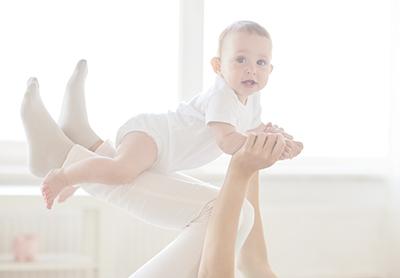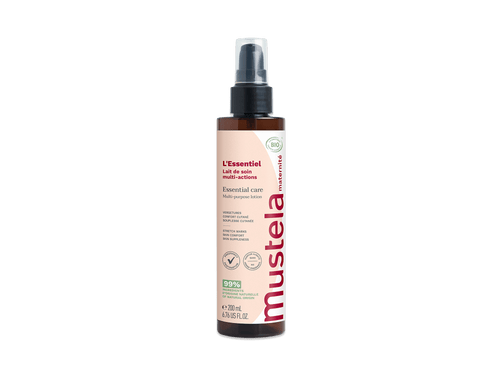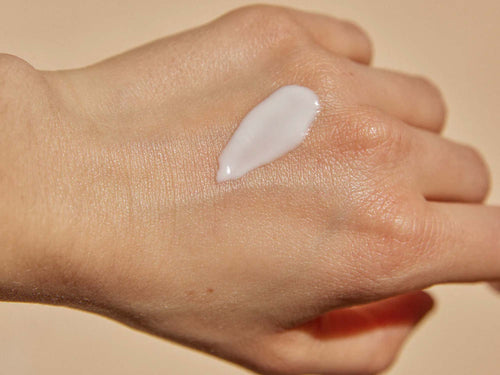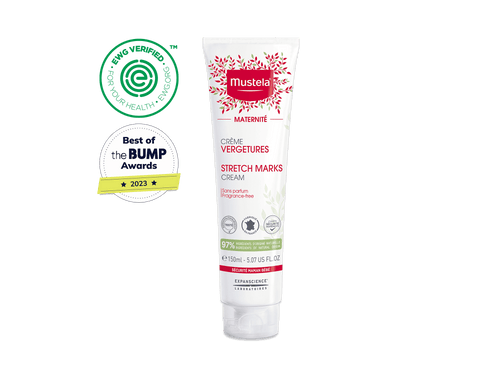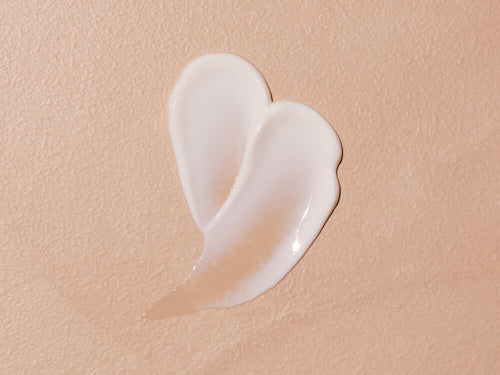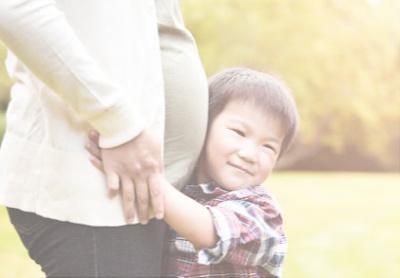Pregnancy and birth bring about a lot of changes to your body. Whether it’s loose skin, stretch marks, or extra weight, chances are you’re eager to get back to your pre-baby body. Postpartum exercise can help, but you should take it slow. For example, you shouldn’t try running a 10k the week after giving birth. That’s a recipe for unnecessary injury.
If you’re wondering how long you should wait after giving birth to exercise and what exercises to choose, don’t worry, we’re here to help. We’ve put together a list of nine tips to help you ease back into exercising, avoid injury, and shed that loose skin and extra weight permanently.
But first, let’s take a look at the benefits (there are many!) of postpartum exercise. Seeing the good it can do might be the push you need to put on your shoes and get out the door or roll out that yoga mat you have in the living room.

Benefits Of Postpartum Exercise
There’s nothing wrong with working on restoring your pre-baby body, and postpartum exercise can help you get there. But it’s also good to remember that exercising after having a baby is good for you in plenty of other — equally important — ways.
Getting back into shape brings short-term benefits, like promoting baby-weight loss and improving your muscle tone (helpful for carrying around your new baby!). But it also sets you up for good habits and a healthier long-term future.
Being active is good for your mental and emotional health, too. It can improve your mood and reduce postpartum depression and anxiety. If that’s not a good enough reason to get moving, here’s another one: more energy!
Getting out for a walk or going to the gym might be the last thing your tired, new-mom self wants to do, but the right amount of exercise can give you more energy, not less. You’ll probably notice that you’re a bit more energized and less fatigued after working out. Exercising might also help you sleep at night, which is great news for any new parent.
Finally, if you’re going to a gym class or working out with your partner or friend, exercising doubles as social time. Or maybe you just need some alone time and that’s okay, too.
As you can see, postpartum exercise is beneficial however you look at it. It’s one way to take care of yourself, which also allows you to take better care of your little one.
Now that you’re convinced, motivated, and ready to get moving, here are our tips for postpartum exercise.
13 Tips For Postpartum Exercise

1) Talk To Your Doctor First
Talking to your doctor is a key first step towards achieving your postpartum exercise goals. They may give you the go-ahead right away, or suggest that you wait a few weeks before you resume exercise. Some may even recommend waiting until after your six-week checkup. Sure you may feel ready to go, but listen to your doctor’s advice.
We suggest you talk to your doctor before leaving the hospital after giving birth. Just ask them what kind of physical activity they recommend. If you have something specific in mind, like rowing, running, or yoga, bring it up and see what they say. That way, you’ll know exactly what you can and cannot do when you get home.
2) Let Your Body Recover From Giving Birth
Your body has just been through a lot. The muscles in your hips, thighs, and belly have been put to the test. Your breasts are bigger and put more stress on your back and you’re probably carrying more weight than you were before you got pregnant. Oh, and let’s not forget that you just brought a new life into the world!
Give your body time to recover before starting any exercise program to avoid the risk of unnecessary injury. Waiting at least a week or two allows your body to heal and your hormones to stabilize.
3) Take It Slow

When your doctor gives you permission to start exercising—whether it’s right away, or after your six-week checkup—start out small and slow.
You may have been doing CrossFit workouts with no problem before you got pregnant, but a lot has changed in the past nine months. Jumping back in where you left off and expecting to do your old workouts right away can be dangerous.
We recommend starting with activities like walking, light calisthenics, and stretching. They may not seem like much right now, but consider them as testing the water. You need to see what you can and can’t do with your new body.
Try a fifteen-minute walk with your baby, perform some body-weight squats (sitting down and standing up from a chair repeatedly works well to start), or put together a light yoga routine.
When you know you can do short, light activity comfortably and without pain, gradually build in duration and intensity. Just remember, starting out small and slow and building from there is much better than pushing too hard, injuring yourself, and having to wait an additional six months to a year.
4) Do What You Can

While some women will want to jump right back into working out, maybe you’re having the opposite problem. Either you never liked to exercise in the first place or your post-baby body and fatigue are making it difficult for you to get motivated.
Don’t beat yourself up. Instead, focus on doing what you can.
Only feel up to a five-minute walk? Start there. A five-minute walk is better than no walk at all! Even moving around a little bit might be enough to put a pep in your step and help you gain momentum for more the next day.
5) Choose The Right Postpartum Exercise
Exercises like walking, swimming, water aerobics, and yoga are good options for postpartum exercise. For those just starting out, low-impact aerobic activities and stretching are often best. Other recommended low-impact choices include the stationary bike, elliptical machine, and stair-climber machine at the gym. Be sure to take it slow at first and build your duration and intensity.
Another fun postpartum exercise option is a class for new moms. Check for a Strollercize or a Baby Boot Camp program at your local gym. These classes are a great way to get out of the house, get some exercise, and socialize with other new moms.
6) Practice Pelvic Floor Exercises
Doing pelvic floor exercises (also called Kegels) doesn’t take the place of cardio like walking, but it’s important for your post-baby body.
With the small movements of pelvic floor exercises, you’ll slowly strengthen your pelvic floor, which helps avoid urine leakage and pelvic organ prolapse (like bladder prolapse). Plus, once you’re ready to have sex again, a strong pelvic floor can make it more enjoyable!
Your doctor or a physical therapist can help you learn how to do Kegels and make sure you’re doing them correctly. Once you get the hang of it, the nice thing is that you can multitask! If you want, do your Kegels while reading a book or sitting in the rocker breastfeeding your baby.
7) If You Take A Class, Let Your Instructor Know You Recently Gave Birth
Exercise classes for new moms are specifically tailored to avoid movements that could cause injury during the weeks and months after giving birth.
Other classes, though, like spin and yoga, may include movements that are too intense for your postpartum body. But don’t let that deter you from participating. They’re still great options. Just be sure, to let your instructor know you recently gave birth.
She can then alter the workout slightly to accommodate your fitness level. At the very least, she will know what’s going on if you decide to slow down, rest, or skip a particularly difficult pose.
8) Find A Workout Buddy
Getting to spend time with a friend or family member while working out could be the extra motivation you need to start exercising. And it’s hard to put off working out if you have a buddy waiting for you at the gym or the park!
Or your workout buddy might be the smallest member of your family: your new baby! While they can’t hold you accountable, they can lie next to your yoga mat or ride in the stroller while you walk.
If you’re taking your little one along for a walk outside during the summer or winter, make sure you dress them appropriately. Wrap them up if you’re outside on a chilly day, and don’t forget sun protection for sunny days.
It also pays to keep Cicastela Moisture Recovery Cream in your diaper bag in case your baby gets bug bites, scrapes, or scratches.
9) Take It Easy On Your Abs

Your abdominal muscles have gone through a lot since you first got pregnant. As your baby grew in your womb, your abdominal muscles loosened and stretched to accommodate your baby. As a result, your abs are considerably weaker than they were when you first got pregnant.
Some women even develop diastasis recti—a gap between their abdominal muscles that may not fully close after delivery. This gap isn’t anything to be worried about. It just means that you need to be gentle on your abdominals muscles for the first several months after delivery.
We recommend skipping traditional sit-ups and crunches and instead trying planks. Planks are great for toning, tightening, and muscular endurance because they require you to use your core, hip, and glute muscles for extended periods of time. Be sure to ask your doctor about what you should and shouldn’t do to strengthen your abs.
10) Wear The Right Bra
Whatever exercise you choose, be sure to wear the right bra. The bra you wear can be the difference between an enjoyable exercise experience and a painful one.
We recommend a supportive sports bra whether you’re walking, stretching, or even swimming. If your breasts still feel sore, try wearing two sports bras for extra support. If possible, try exercising after you’ve nursed your baby so your breasts won’t feel overly full. If skin irritation and soreness develop, try applying a healing product like Mustela’s Soothing Moisturizing Balm or Bust Firming Serum.
A comfortable bra is especially important if you’re dealing with cracked nipples. You want to treat your nipples as gently as possible by wearing a bra that’s not too tight or too rough.
One more way to show sensitive nipples some TLC: after breastfeeding, apply Mustela’s Nursing Comfort Balm. This fragrance-free cream is made of 100% food-grade ingredients and contains nourishing olive oil, which is rich in Omega-6 and 9. It’s also eco-friendly and safe for both you and your little one.
11) Work Up To Weighted Exercises
While restarting your exercise routine with low-impact aerobics and stretching may not be what you were used to before becoming pregnant, it’s the smart and safe thing to do. Eventually, though, you need to add some strength movements to your routine.
The hormones released during pregnancy have made your muscles looser and thus, weaker. Weighted exercises will strengthen your muscles, tone your body, and help relieve and prevent back and joint problems.
Weighted exercises include everything from calisthenics like pushups and body-weight squats, to dumbbell and barbell exercises like deadlifts and shoulder presses. We suggest starting with body-weight exercises to gradually build your strength. A simple routine like three sets of five pushups, five pull-ups, and five squats can work all the major muscle groups in your body.
Can’t do a full pushup or pull-up? Don’t worry. You can modify the exercises to match your abilities and work up to the full movement over time. Talk to your doctor or a fitness trainer to see how you can modify bodyweight movements for your fitness level.
12) Eat Well
This tip isn’t directly related to lacing up and hitting the road or getting your yoga on. But nutrition certainly plays a big part in feeling good and losing postpartum weight. Eating healthily and exercising go hand in hand, so don’t focus on one and neglect the other!
Breastfeeding moms should follow a healthy breastfeeding diet that includes lean protein, whole grains, healthy fats, lots of fruits and vegetables, and of course plenty of water.
Drinking enough water is key to staying healthy and hydrated during and after exercise as well.
13) Listen To Your Body
We know you’re mentally ready to get back into an exercise routine so you can get your pre-baby body back, and that’s great. But it’s more important to listen to your body than to take on too much, too soon. If you do, your body will let you know and it likely won’t feel good.
Signs that you’re doing too much include:
- Feeling exhausted instead of energized after a workout.
- Prolonged soreness in your muscles that affects your body’s ability to properly support itself.
- Shaky muscles.
- A morning resting heart rate that is ten beats per minute higher than your regular heart rate.
If you experience any of these symptoms, take a break from exercising, rest, and talk to your doctor about altering your workout routine.
Take Care Of Yourself As You Care For Your Baby

Your world now revolves around your new little one, and most of your day is spent looking out for their every need. In the midst of caring for your baby and everything you’re juggling as a mom, make some time to take care of yourself.
That includes pampering your skin with Mustela’s Stretch Marks Oil as well as getting some exercise for the health of your mind and body. Follow our tips for postpartum exercise and stay active so that you can be the healthiest version of yourself and ready to give your best to your precious baby!


